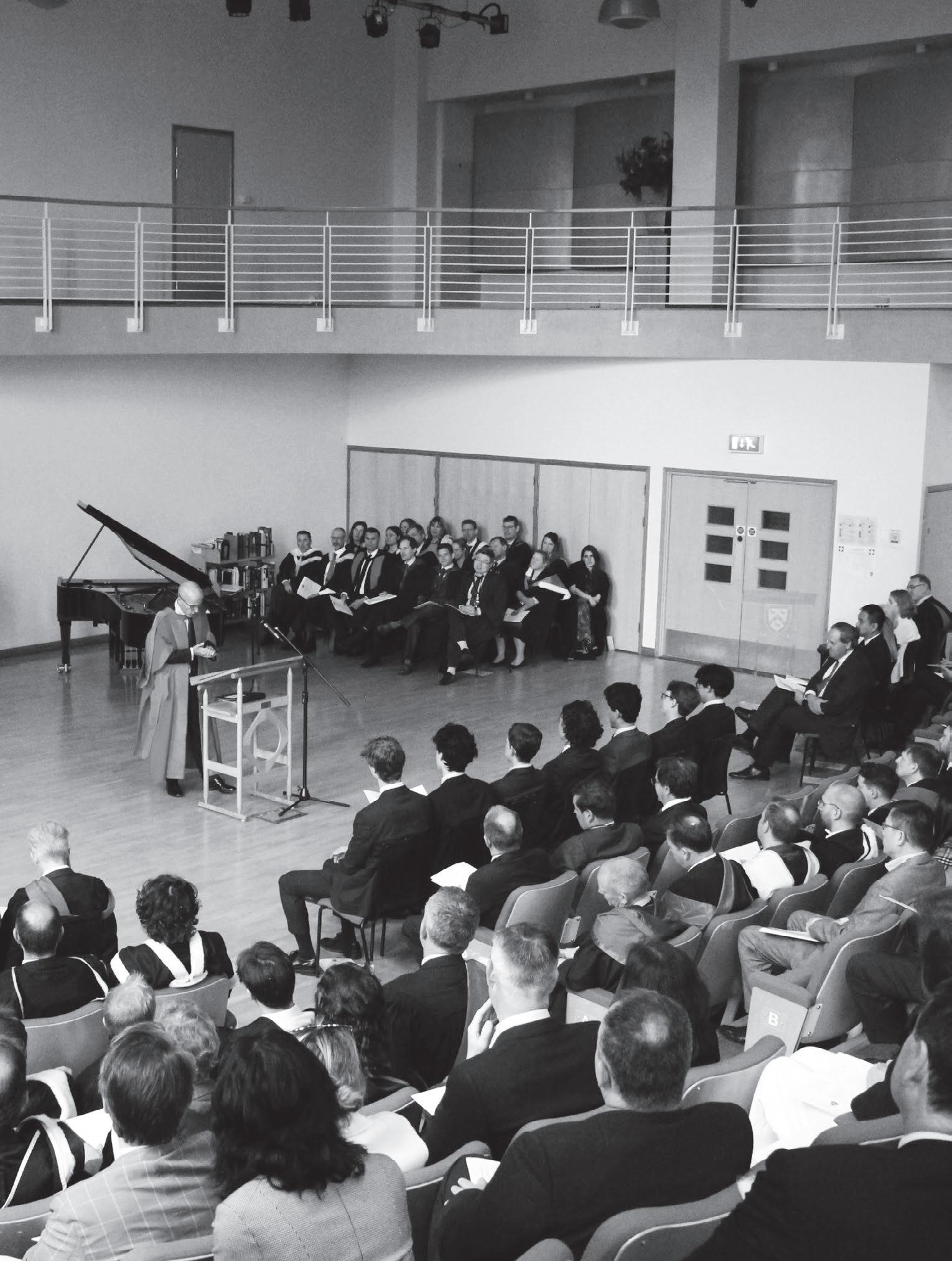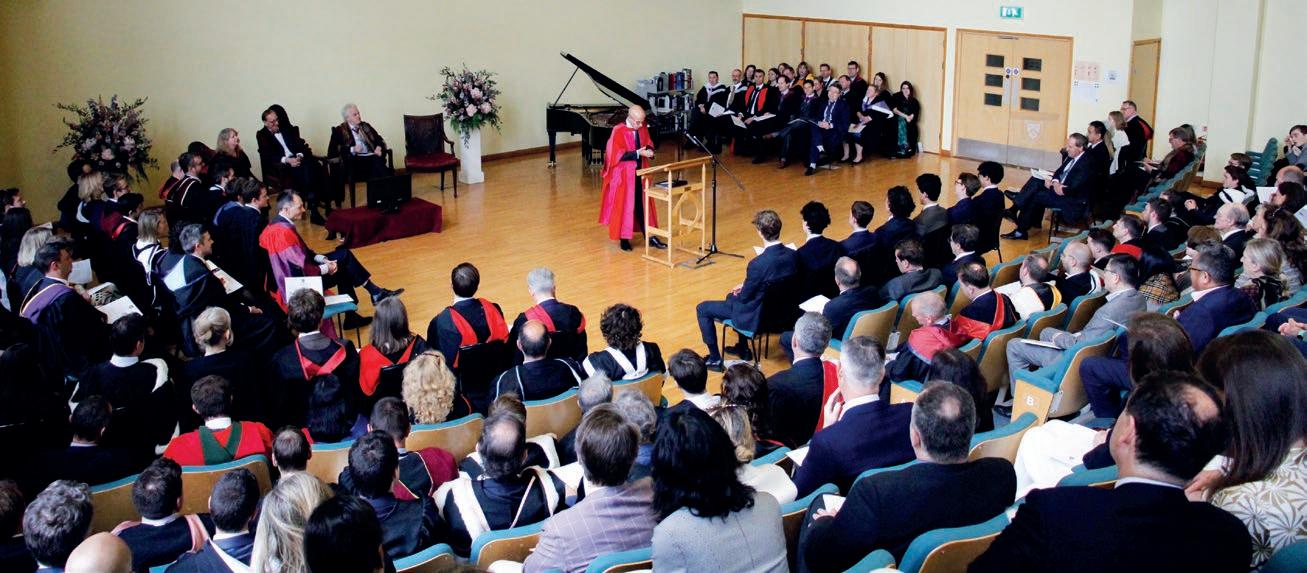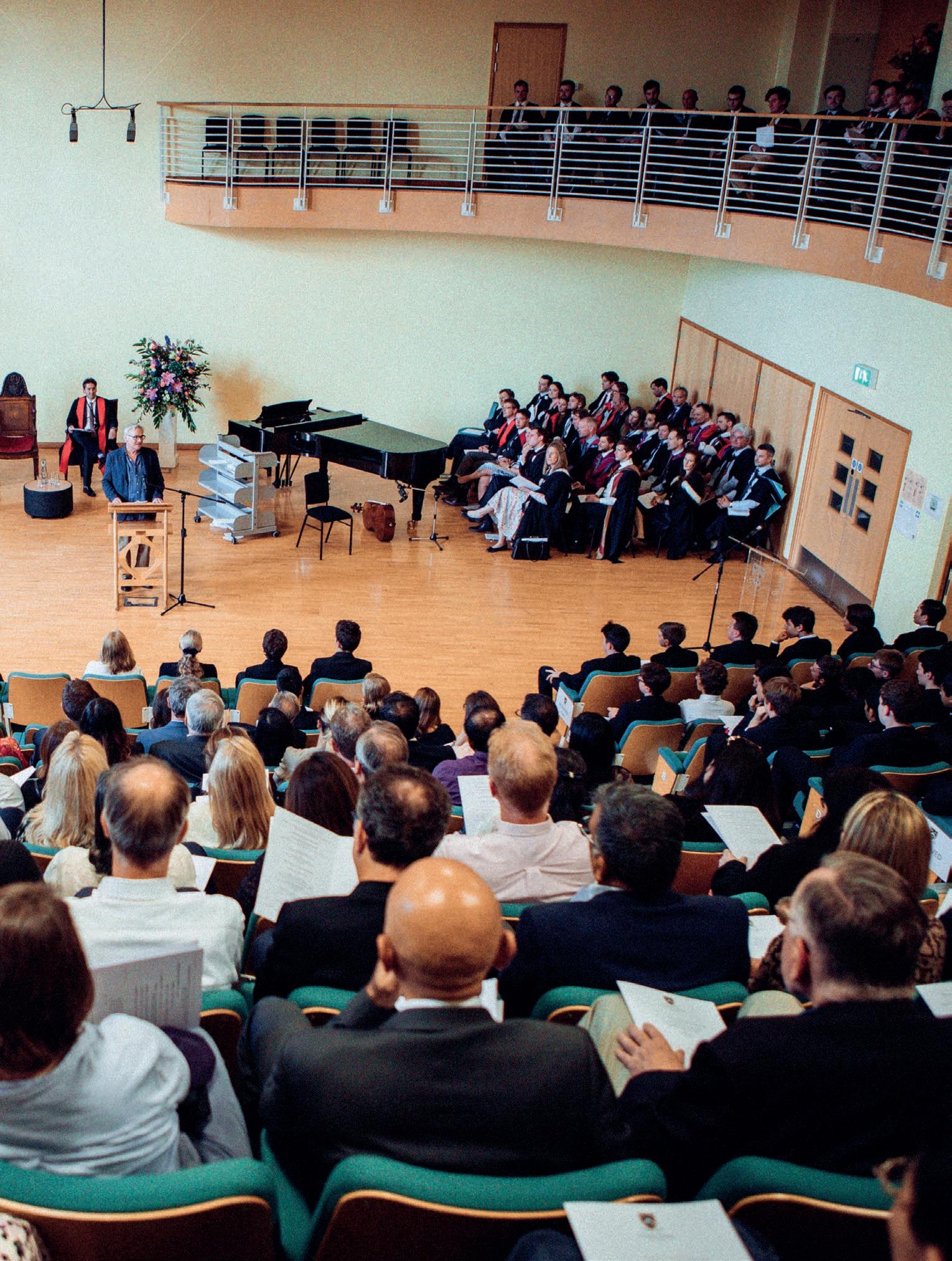
14 minute read
Apposition
MJPS
On a glorious spring morning, Apposition returned to St Paul’s. Following Matins in the newly consecrated chapel, prizewinners, their guests, staff and dignitaries were treated to an exhibition of Hugo Berman’s (Upper Eighth) photography, including some spectacular aerial shots of London during lockdown, before taking their seats.
You can read declamation abstracts from Finn Lavington, Omar Burhanuddin, Eamon Coates and James Lawson. The Apposer, Professor Charles Swanton, Old Pauline and eminent cancer researcher, responded in great depth – taking as his unifying theme that of peer review. There could have been no more apposite Apposer for Finn’s declamation on the medical challenges of a journey to Mars.
On the basis of Professor Swanton’s favourable remarks about the state of scholarship at St Paul’s, Master Mercer and governor Chris Vermont saw fit to reappoint the High Master for the coming year. Between the speeches and the prizes, Calvin Leung thrilled all present with an electric rendition of Liszt’s Transcendental Etude No. 8, complete with a piano that threatened to get away from him in his more forceful moments.
Ninety-one prizewinners then collected 118 prizes ranging from The Female Eunuch (Truro Prize for mathematics) to Spirited Cocktails from Around the World (OP Club Prize for outstanding service to the school) before the High Master concluded the ceremony and everyone went for lunch.
Overcoming our nature on the journey to Mars
Finn Lavington
The 20 July 1969 was a seminal date in history. The grainy images of Armstrong’s “one small step” united a polarised US, fractured by the Vietnam War and captured the imagination of the world, with even the Soviet premier Leonid Brezhnev sending his congratulations. But NASA saw the moon landing as a stepping stone and not the end of the Apollo era.
They dreamt of a module much like the space station orbiting the moon by 1978, a large 50-person station orbiting Earth by 1980 and a lunar surface base that same year.
They even had detailed plans of landing humans on Mars by 1983. However, along with Nixon-era budget cuts, the race into space slowed because the challenges of long-term exposure to the cosmic environment became better understood. Yet this obstacle is not an engineering problem, but a medical one. The human body, we have discovered, is just not adapted for long-distance space travel; our own immutable biology is holding us back. So how can we use the recent advances in modern medicine and technology to surmount this obstacle and overcome our nature in the journey to Mars?
One of the most significant risks to the crew’s health comes from the high dosages of cosmic radiation they would experience on the journey to Mars. Throughout this 21-month long voyage, the astronauts’ cells would be bombarded with thousands of heavy charged ions contained within these cosmic rays. When these ions penetrate the nucleus, they can form reactive oxygen species (ROS) which can interact with our DNA, causing it to break. In most of these cases, this damage is recognised and, if irreparable, the cell undergoes programmed cell death in a process known as apoptosis. Here, in this cellular mechanism, is where the crux of the problem lies: if more cells are being killed by this radiation-induced apoptosis than are being created, the astronauts’ tissues would begin to waste away. Whilst this would be most visibly obvious in the astronaut’s shrinking muscles, atrophy would be most lethal in their central nervous system tissue – the collection of neurons in the brain and spinal cord that control all aspects of the mind. The ensuing neurodegeneration would likely result in a progressive decline in cognition, memory and fine motor skills in a manner similar to an accelerated dementia.
In my declamation, I suggest two methods of treating this radiation-induced atrophy. The first one I propose is using the antioxidant glutathione to neutralise the reactive oxygen species before they can damage the DNA. The second, more risky method, would be to inhibit apoptosis altogether by interfering with its cellular signalling pathway.
Should we tell history like we tell stories?
Omar Burhanuddin
Should we tell history like we tell stories? Does literary historical narrative – the tradition of Gibbon – enrich our understanding of the past?
George Dangerfield’s seminal 1935 work, The Strange Death of Liberal England, would suggest so. On the surface, it appears intrinsically ahistorical. Dangerfield explicitly referred to the ‘stage’ set up, and the ‘curtains’ pulled back, drawing attention to the fictive theatricality of his work. A deeper reading, however, reveals how Dangerfield exposed the turbulence of Edwardian political life. He gave the lie to the prevalent myth of the pre-war English Belle Époque in an accessible manner. In this way, artistic license facilitated a greater historical understanding.
But this is not the end of the story. History-as-narrative is acutely vulnerable to exploitation to serve ulterior, presentist motives. Consider the misuse of the ‘Century of Humiliation’ interpretation of Chinese history. The original interpretation argues that, in the long view of Chinese history, the Maoist regime did not represent an aberration, but a restoration. Mao supposedly ended the traumatic century between the First Opium War and the 1949 Revolution – the real aberration in the history of China – and reclaimed China’s historic independence.
Now, by itself, that argument is illuminating. It explains why, for all his evil, Mao remains the most revered figure in Chinese national memory. And yet, the Chinese Communist Party has continued to appropriate this narrative to legitimise its rule and practices, from the genocide in Xinjiang and their abandonment of the ‘One Country Two Systems’ principle in Hong Kong, to broad claims in the South China Sea and denial of Taiwanese sovereignty. From this and so many other examples – Vladimir Putin’s essay of August 2021 comes to mind – it is clear that historical narratives never stand alone. They always run the risk of serving cynics. Poststructuralists would deride the supposedly naïve moderation of this judgement. Narrative is not simply ‘vulnerable to exploitation’, they would claim, but is in fact always an exercise in the deployment of power. To this, I can only respond by appealing to Dangerfield’s good example. By rejecting preachiness and embracing theatricality, Dangerfield preemptively withdrew the sting from any potential weaponization of his narrative. He demonstrated the supreme good faith required for the fusion of history with literature.

The resources of a clean future
Eamon Coates
All the problems of humanity and most of the problems of individuals have clean energy in their denominator. I will discuss why an entirely renewable grid is impractical, and how a material called monazite can deliver carbon neutrality.
The cleanest and most versatile sources of renewable energy – wind and solar – are a poor choice as the foundation of our electrical grid due to their intermittence. If we wanted to supply all our energy needs through wind and solar, we would have to overbuild by 4 to 5 times the size of the grid, essentially paving the country. Further, while renewables are getting cheaper, the resources they require are too geopolitically contested, and too monopolised. Were we to commit to a grid of renewable energy, we could find ourselves dangerously vulnerable to supply shocks.
The solution to these issues is one often regarded with caution. It is nuclear power, albeit revamped. Nuclear power is not strictly ‘renewable,’ as it requires resources which we have to dig up out of the ground. Large third-generation (standard tech) nuclear power plants, and their enriched fuel, are expensive. The word ‘nuclear’ has dangerous associations, because of nasty waste products and weapons projects. New technology, however, known as fourthgeneration nuclear power, can correct these drawbacks, using small modular reactors (SMRs), ‘breeder’ technology, and new safety features like molten salt cores. Breeder reactors could not only vastly improve energy output per kilo of fuel but also run on existing nuclear waste, reducing existing inventories to negligible amounts, as well as creating elements which can be repurposed for use in medicine. SMRs could transform the grid with a net positive environmental impact. Best of all, fourth-gen tech makes use of thorium as fuel, which is four to five times more abundant than uranium (meaning even more bang for the buck) and whose waste is clean and cannot lead to proliferation. The ore of thorium is a mineral called monazite, which also contains rare earth metals. It is hugely abundant, as it is a component of heavy mineral sand. THIS is the resource of a clean future. Not only would a widespread focus on monazite spell the reclamation of secure rare earth production, but it would supply enough fuel for thousands of years of clean energy. There are deserts full of it everywhere: in India, Australia, and even the United States, all countries which can provide a sustainable and secure flow of material.
The fourth-gen thorium reactor can offer up to 250 times the energy of third-gen nuclear per unit currency. And it takes up 80 times less space than solar or wind. The necessary resources are secure, abundant, and convenient. Nothing is handed to us on a silver platter, but monazite comes quite close.
Consent in the data economy: the perils of clicking ‘I agree’
James Lawson
When the internet was in its infancy, the entrepreneurs of Silicon Valley promised a utopian world in which our daily lives would be transformed for the better, where total knowledge and freedom were available to all. At the same time, science fiction writers warned that our daily lives may become a nightmare where all knowledge and power is concentrated in the hands of a privileged few.
Such views of a digital future seem contrasting, but for many they are one and the same. In 1967, Herman Kahn published his book, The Year 2000, in which he predicted the rise of automated systems of surveillance and control where individual behaviour was constantly monitored and directed by machines. He described these systems as “a twenty-first century nightmare.” In contrast, behavioural psychologist B.F. Skinner described similar systems in his book, Walden Two, which he interpreted would help build a “utopian community.”
Despite seeming futuristic and far out of reach, this world may soon be realised. After the ‘dotcom bubble’ burst in the early 2000s, Google, in desperation, discovered a new business model: behavioural data produced by users on the internet could be utilised to target advertisements to a more accurate degree than ever before. Since then, this practice has extended across both the online and offline world and has led to the formation of the ‘data economy’, a term that encompasses the processes employed by firms to collect, analyse and use personal data in order to predict and influence behaviour. In the last twenty years, the data economy has spread across the globe, encompassing the vast majority of the 4.7 billion people that currently use the internet. It pervades across and throughout our lives, mediating virtually every transaction as well as most of our communication, entertainment, work and private lives. Despite its ubiquity, the practices of the data economy have been continually contested and questioned: in response to Google’s Street View controversy, WIRED Magazine boldly declared “Google is Evil”; in 2016, Mark Zuckerberg was made to testify in Congress about the Cambridge Analytica scandal that shocked democracies across the world; and Shoshana Zuboff, in her seminal work on the data economy, described it as “a different kind of challenge… one that threatens the existential and political canon of the modern liberal order defined by principles of self-determination that have been centuries, even millennia, in the making”.
Therefore, given its potential danger, the data economy clearly needs to be examined. In my EPQ, I sought to understand the full costs and benefits of the data economy, which I then assessed against a range of ethical criteria. Here, I shall focus on the most important aspect of this: the way we are coerced into giving “consent” to the exploitation of our personal data, and my talk will be in three parts. First, I will illustrate the harmful consequences of the data economy. This includes the ways that data companies record our movements, moods, habits and preferences on a near-constant basis, and subsequently advertise to exploit our weaknesses and vulnerabilities. It also encompasses how banks, insurers, employers and landlords regularly buy and sell this data, using it to potentially deny us access to housing or a job. Second, I will explain why the data economy fails to respect informed consent, an important concept in medical ethics which requires that we fully comprehend a thorough disclosure, voluntarily giving our affirmative, explicit consent. Third, I will propose my solution to this problem. In particular, I suggest that on an individual level, we should all aim to use privacy friendly alternatives wherever possible. However, this is not enough on its own. A large-scale approach is needed, such as regulating, breaking up or nationalising the data economy. Whichever approach is taken, it should prioritise robust models of informed consent, allowing us to weigh the costs against the benefits of giving up our data. This would reliably safeguard our autonomy whilst promoting our well-being, so that we might reclaim our actions and begin to reshape our lives, our communities, and our democracy.
By clicking ‘I Accept’, you agree to our terms and conditions”
‘Consent’ given by four billion people every day
FACULTY OF CLASSICAL AND MODERN LANGUAGES
BEDFORD PRIZE – Ancient History T U Siri Heath
KYNASTON PRIZE – Greek J M W Davies
CYRIL BAILEY PRIZE – Latin F A Stock
FRITSCH PRIZES – French A D M Baines, C M Garzarelli
BENTWICH PRIZE – German F A Stock
GWYNN MIELL PRIZE – Italian A Popat
MARCUS PRIZE – Spanish N D Boyd-Carpenter
FACULTY OF HUMANITIES
HAMILTON PRIZES – Geography K Akyol, G G B Davies
CLEMENTI PRIZES – Geography J G J Thomas, R J G Wight
CHIBNALL PRIZES – Economics K Chan, F D H Saunders, J W Trotman
BARNETT PRIZES – Economics J Abuzayyad, C G E Bulmer, W Huang, M Jian, A Kochhar, S Sivarakulan
MORGAN PRIZES – Politics C A B Grimstone, L A I Odgers
WALKER PRIZES – Politics L G Cadman, C F Traynor
ISAIAH BERLIN PRIZES – Philosophy M Bose, H T G M Collins, A H Whitham
LUPTON PRIZES – Philosophy N R Martin
BEDFORD PRIZE – History A H Kenny
WEINSTEIN PRIZE – History C M Garzarelli
SABUROV PRIZE – History C Robertson
TRURO PRIZE – History A N Gong, N T Leach, C F Traynor, A T P F Vecchioli
FACULTY OF ENGLISH
MILTON PRIZE – English H T G M Collins
BUTTERWORTH PRIZE – English N D Boyd-Carpenter
SABUROV PRIZE – English N O Pavell
TRURO PRIZE – English T M W O’Donoghue
FACULTY OF CREATIVE AND PERFORMING ARTS
JOHN WATSON PRIZE – Art L R G Gordon, J W Oudkerk
SADIE PRIZE – Music C D Leung
MILLER PRIZE – Theatre Studies L A I Odgers
LIDWELL PRIZES – Extended Projects H O Berman, J W Trotman
FACULTY OF SCIENCE, TECHNOLOGY AND ENGINEERING
CREE PRIZES – Biology A A Apkarian, A O Ball, Z S Farazi, R Kusakari, K S Philipose, A M L R Richards
PERKIN PRIZES – Chemistry J J B Abbosh, S S Arora, P J Baker, D F I Buxton, E Coates, E D T Doughty, A Durantel, R Kusakari, F O J Lavington M D S Smith
HALLEY PRIZES – Physics V Bhamre, R Chen, H (Danny) Cui, E Fizesan, O S Hiorns, N J Land, J Leventis, S Noubir, E J Shah
RENNIE PRIZE – Engineering R H Pilnik
GLUCKSTEIN PRIZE – Computing M J Bowman, Y Dubey, T P Langer, D Pattem
FACULTY OF MATHEMATICS
BURKHILL PRIZES – Further Mathematics A Ahilan, M J Bowman, K Chan, R Chen, G D H Ching, J W Cubbon, T P Langer, S Noubir, R Oomer, J J Roberts, M H L Wrench
TRURO PRIZE – Mathematics S J Bottomley, E Coates, E J Shah, M D S Smith
JOHN COLET PRIZES
for outstanding academic achievement O M Burhanuddin, S Fakiolas, A Imam-Sadeque, S A Karim, L C Kirkpatrick, J E Lawson
HALDANE PRIZES
for declaimers O M Burhanuddin, E Coates, F O J Lavington, J E Lawson
THE BLUMENAU PRIZE
for philosophy I W A Throsby
THE GRITTEN PRIZE
for International Relations D Fitzpatrick
THE ANDRE FU PRIZE
for an outstanding work of art C E H Hunt
THE VIITA PRIZE
for a piece of new writing or composition T Bailo, E J Patterson
THE PROFESSOR TONY CROOK PRIZE
for an outstanding essay for geography related to a public policy M S Howorth
HIGH MASTER’S PRIZES
for outstanding summer essays S J Bottomley, O M Burhanuddin, R Chen, E Fizesan, C M Garzarelli
THE REYNOLDS PRIZES
for all-round achievement L P D Wilson
THE VERMONT PRIZE
for outstanding service to the school B T G Harrison
THE WATHEN PRIZE
for outstanding contribution to the school T Thorogood
THE BLAIR PRIZE
for thinking creatively and laterally across disciplines H T G M Collins
THE OLD PAULINE CLUB PRIZE
for outstanding service to the school W J Shackleton
THE JOHN WEITZ AWARD
for outstanding service to the school G G B Davies











